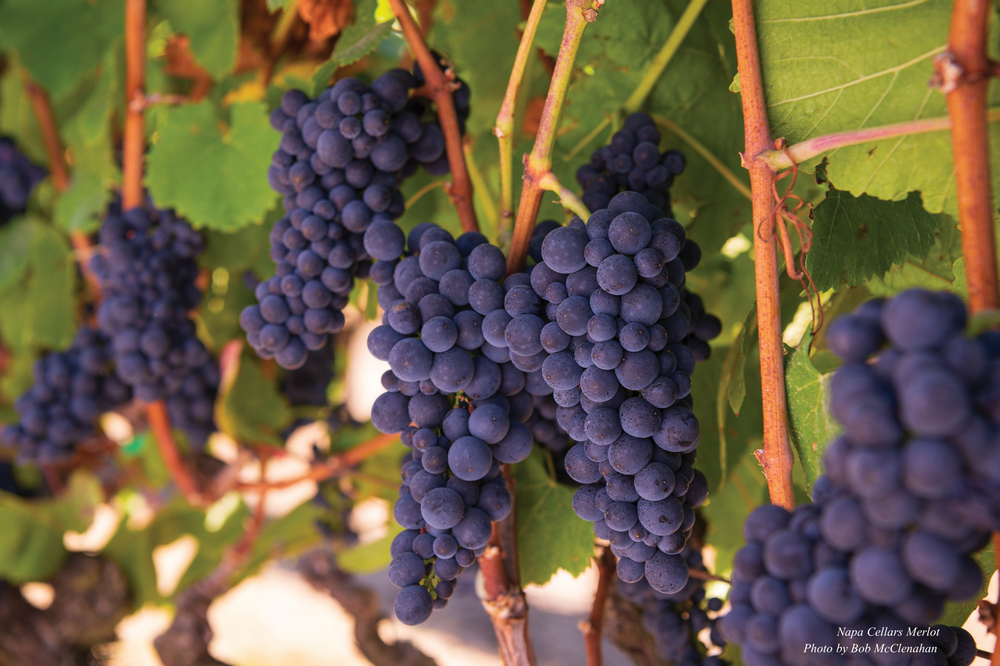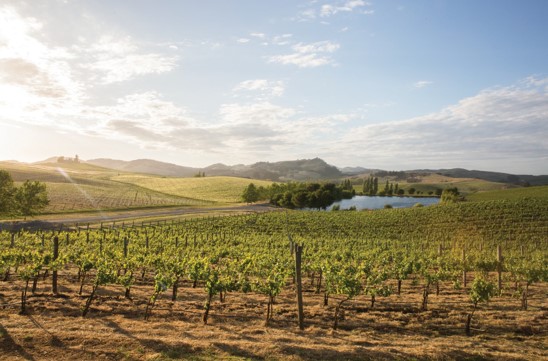Tracking its renaissance in Napa Valley
Over the past 50 years, it’s hard to imagine where the wine mecca of Napa Valley would be if not for Merlot’s early success, the noble red grape variety that burst on the scene in the late 1970s. Especially when one considers the series of phenomenal accomplishments that this amiable grape made as the leading wine purchased by American wine consumers, retailers, and sommeliers in the 1980s and 1990s.
In the beginning, Merlot was mainly used as a blending grape in the famous wine-growing region of Bordeaux in France before it arrived in the New World. But that started to change after classic Napa Valley brands like Louis M. Martini, Newton, Sterling, and Trefethen slowly worked with the grape after World War II, and Duckhorn Vineyards became the first winery to bottle the variety on its own in the late 1970s.
When the inaugural Duckhorn releases hit the market in 1978, the Merlot was priced at $10.50 and the Cabernet Sauvignon at $10.00. According to veteran winemaker Tom Rinaldi, who crafted the spirited Duckhorn wines for the first three decades, the price differ- ence reflected not only the great potential of Merlot in the marketplace but also the challenges that go along with finding the best sites to plant a grape that performs best in more moderate climate areas.
For these reasons, the classic Duckhorn Napa Valley Merlot comprises a selection of select lots from estate vine- yards and ultra-premium fruit sourced from other cool-climate sites located in the valley. Duckhorn’s rich, round, and complex iterations helped put Merlot and Napa Valley on the global wine map, and the winery earned a reputation for its separate appellation series and single- vineyard designates such as their Three Palms Vineyard, which earned the prestigious “Top Wine of the World” honor from the Wine Spectator in 2017.
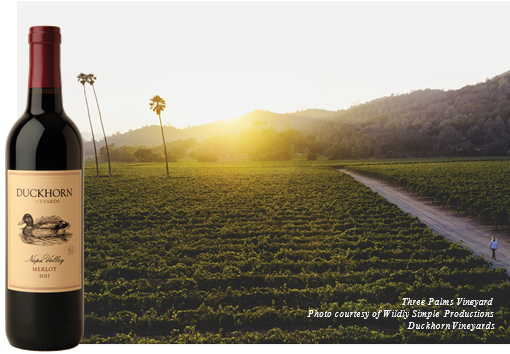
Over time, the success of these stylish wines and many other delicious Merlot offerings from Napa Valley led to a broad expansion of new plantings on the West Coast and the marketplace’s eventual saturation before it peaked in the early 2000s. And like a call from the wild: “I am not drinking any f***king Merlot!” was the memorable line quipped in 2004 by the main character Miles (played by Academy Award-nominee Paul Giamatti) in the smash film Sideways that helped flatten the curve and eliminate the mediocre wines bunched in this category. Winemaker and viticulturist Steve Matthiasson, who has been bottling Merlot from the Oak Knoll District in southern Napa Valley for his family’s Matthiasson label since 2006, said the well-timed connection between Merlot and the film was a necessary purge. “In my opinion, Sideways really did Merlot a favor because the varietal was over-planted in too many spots that weren’t suited for the grape. For that reason, the only vineyards that remain in Napa Valley are places where Merlot grows extremely well.”
Since then, this exciting renaissance of Merlot has been fueled by new farming techniques that have allowed a passion- ate group of vintners and growers in Napa Valley to produce some of the world’s finest offerings of Merlot over the past two decades. To spread the word about this new movement, the merits of this steady stream of delicious, thought-provoking wines are now promoted in a series of annual festivities, which include Merlot Month in October, International Merlot Day in early November, and other year- round activities put on by the 100-plus winery members of the #MerlotMe organization started by Duckhorn Vineyards in 2013. On a larger scale, this network has reached more than 25 million wine drinkers and generated more than 100 million social media impressions in 30+ countries over the past five years.
VALLEY FLOOR DELIGHTS
One of the strong brands to consistently produce flavorful wines through the decades is Markham Vineyard, which became the fourth winery to bottle Merlot in Napa Valley in 1980 and later named the “Merlot of the Year” by the Wine Spectator in 1990. To continue this tradition, head winemaker and general manager Kimberlee Nicholls said the team’s goal is to steadily increase the “yummy factor” of the Markham Merlots.
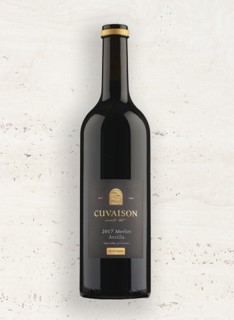
“It’s pure luxury when you can work with cherry pie notes from Oak Knoll, black cherry and cassis notes from Oakville, and lift the ripe boysenberry flavors with natural richness and layers of complexity generated from the vines planted in the hotter area of Calistoga, too,” said Nicholls.
Other examples of high-class wines from the valley floor include the smooth, rich, and blue-fruit laden Merlots coming out of Rutherford from producers such as Freemark Abbey, Rutherford Ranch, St. Supery, and Sequoia Grove, to name a few.
This new wave of Merlot offerings from Napa Valley is ready to dazzle the palates of devoted red wine fans and the new generation of wine lovers.
MOMENTOUS MOUNTAIN MERLOTS
As the decades have passed, a series of significant contributions to this positive momentum has come from high-elevation sites that are cooler during the day and warmer at night. Planted on the west-facing slopes of Howell Mountain, Beringer has made an exceptional vineyard-designate Merlot from the Bancroft Ranch since 1987. Other compelling examples include the deep, dark fruit flavors of the Estate Merlot from the historic La Jota Vineyard or Pahlmeyer’s Rancho Chimiles Estate Merlot from the Vaca Mountain Range.
Across the valley, more dynamic hillside vineyards are part of the mountainous Spring Mountain District. Inspired by Duckhorn’s early releases, Paloma Winery founders Jim and Barbara Richards planted their first Merlot vines above 2,000 feet on the Mayacamas Range in 1985.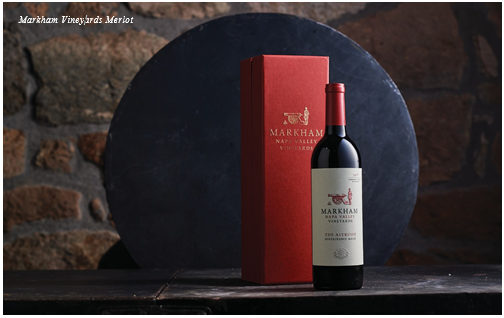
Although this hidden gem only produces a few thousand cases, the family’s commitment to crafting world-class wines received major attention when their big, bold and elegant 2001 Merlot won top Wine Spectator honors in 2003.
COOL-CLIMATE MERLOT OPTIONS
Past the lively fruit flavors, other traditional traits of top Merlots include bright acidity, natural verve, and structure that help preserve the wine’s freshness and longevity for decades. Many of these delectable wines hail from the cool-climate Carneros appellation, which features a multitude of elite vineyards planted in loamy clay soils on the San Pablo Bay border. An excellent case in point is the 2016 Merlot from Hyde Estate Winery, a signature brand founded by local grape growing legend Larry Hyde and his son Chris. Deep, rich, and opulent, with floral aromas, balanced tannins, and firm struc- ture. Equally impressive are the Cuvaison 2017 Arcilla Merlot, which offers plush flavors of ripe cherry and wild berries, and Truchard’s 2017 Merlot, which offers a medley of ripe berry flavors lifted with hints of fresh earth and savory spices.
East of Carneros, other delicious examples can be found in the slightly warmer hillside area of Coombsville. After planting the first Bordeaux varieties in this region in the late 1970s, Tom Farella gained a reputation for producing a rich, mouth-filling Merlot style made with fruit from mature vines located on the rocky terraces of the family’s certified organic estate. “Our goal is to capture a true sense of the vineyard in every bottle we produce,” said Farella.
Other strengths of Merlot can be found in super-premium proprietary red blends. At Shafer Vineyards, Doug Shafer admits that Merlot put his family’s brand on the wine map to stay. But today, the best batches are now being blended with smaller portions of Cabernet Sauvignon and Malbec to provide more layers of complexity, supple texture, and backbone to their premium TD Red Blends.
From light and airy to full-bodied, elegant to ethereal, and precious to powerful: This new wave of Merlot offerings from Napa Valley is ready to dazzle the palates of devoted red wine fans and the new generation of wine lovers. For more information about top producers and upcoming events, visit MerlotMe.com.
FOR MORE INFORMATION
Article By: Chris Sawyer

